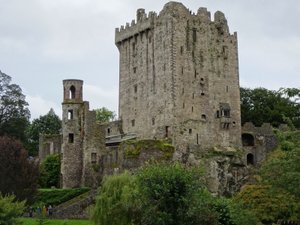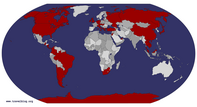Advertisement
Published: December 26th 2019

 Blarney Castle
Blarney Castle
Blarney, IrelandUnfortunately we are back to rainy weather this morning. Early start on our way to Cork and ultimately Kilkenny. We are now headed east on the last leg of our counterclockwise circle around the island.
As we enter county Cork, Tony tells us the story of Michael Collins, the Irish revolutionary leader who came to realize that compromise was the only hope for peace. He signed the peace treaty with Britain in 1922 that created the Republic of Ireland while leaving six northern counties in British hands (Northern Ireland). He knew he was signing his own death warrant because the radical factions saw this act as a betrayal. And, indeed, he was later assassinated. 1.5 million people attended his funeral in Dublin.
We pass through another Irish-speaking area. There have been a few of these on the trip. Here all the signs are in Irish Gaelic. Tony notes that Irish Gaelic words are coming into vogue in Irish English
We have a discussion about drivers licenses in Ireland. Entry level is Leaner, requiring a big L to be displayed in the window. Learners must pass a written test. They cannot drive unaccompanied or on major highways. Their licence
is valid for two years, renewable once. After passing an in-car test, one graduates to Novice, with full driving privileges, but a big N must be displayed in the window for two years.
About halfway to Cork, we stop at the town of Macroom. Like most Irish towns, it has an excellent ruined castle and a lively central market. A lovely town.
Just outside of the city of Cork stands the famous Blarney Castle. It is a magnificent 15th-century castle set in a beautifully manicured garden and park. It has been drizzling all day, but the weather starts to improve just as we descend from the bus. Considering that reaching the castle requires a long walk through the grounds (and that entry is 18€), I elect to go solo.
It's a pleasant walk to the castle. While there are occasional sparse drizzles of rain, the sun is doing its best to peek around the clouds. The park is very attractive, with beautiful flowers and trees lining the route, which passes over a couple of bridges. As I draw nearer, the true scale of the castle becomes apparent. It's a big one, alright. I enter a large ground-level
courtyard, which is crammed with people, then locate the tiny, winding staircase that takes you up to the top. What awaits us there? Why, the famous Blarney Stone, of course. Kissing it gives one the gift of the gab. (My wife has already pointed out that I don't need it.)
The legend of the Blarney stone harkens back to the man who built the castle, Cormac McCartney. The Lord of Munster, he became known for his ability to talk and delay and talk and delay his way out of anything. It was reputedly Queen Elizabeth I who coined the word “blarney” after talking to McCartney, meaning endless eloquence and flattery without substance.
Back at the castle, I’m still struggling up the stairs. The steps are uneven, worn by time and wet from the rain, and consequently a bit treacherous. We climb slowly single-file, with our heads in the butt of the person ahead of us. There is a rope along the wall to help with your balance, but that's it. At the half way point, there are a number of tourists who bail, understandably. One older lady just ahead of me is determined to make it to the

 Town of Cahir
Town of Cahir
Cahir, Irelandtop, and I offer what assistance I can. We finally emerge at the top, which is a huge square around the perimeter of the castle with a drop in the centre to the hall below that served as the halfway point. The lineup stretches all the way around the battlements. As we await our turn, we have a great opportunity to look around. Stunning views of the castle grounds, Cork in the distance to the east, and low mountains in the background.
So here's the Blarney Stone ritual. The stone is part of a wall on one side of the square perimeter, right in the middle. It's the lowest stone of the wall, and there's a dead drop to the ground below it. A set of rusty rods prevents people from falling through, but loose items definitely will. When your turns comes, you lie on your back with your head facing the wall, grasp the handrails on either side, arch your back, push your body back towards the wall, and angle your head down to the bottom stone. Two gentlemen are there to grasp your legs to prevent you from falling. Ok, ready? Now plant an upside-down kiss on

 Cahir Castle
Cahir Castle
Cahir, Irelanda stone that has the saliva of hundreds of people from that day alone. I prudently remove my glasses before attempting this feat and execute it successfully. You will note the improvement in my blog writing going forward.
The way down is via a different winding staircase; same experience as the ascent, but actually even more treacherous because gravity is "helping". Hard on these old knees, but I get down safely. Because it's the digital age, there is a photo of me kissing the stone available for sale in the gift shop at the bottom. Why not? I likely will not repeat the experience.
After leaving the castle, I explore the gardens a bit. There are themed areas, included a “poison garden” showcasing such deadly plants as tobacco and marijuana. To be fair, there is also nightshade, mandrake, poisonous mushrooms and a host of other plants that can incapacitate or kill you.
Heading away from the castle, I spy Badgers Cave beneath the castle walls. When Queen Elizabeth’s patience wore out and Cromwell’s forces captured the castle by force, they found that the garrison had fled through a series of secret underground caves. Reputedly there are three
separate routes that can be taken. I love caves, so I duck my head and waddle in. There is some lighting, but it’s not very good and I am deadly afraid of cracking my head open on the rough ceiling, so I don’t go very far before retreating. People must have been shorter in the 15th century.
I retrace my steps through the expansive gardens to Blarney Village. What have other members of our crew been doing while we were at the castle? Why, shopping at Blarney Woollen Mills. Originally built in 1823, the huge complex is no longer a woollen mill at all but rather a series of shops with a focus on Irish heritage. In other words, a classy tourist trap. We have lunch in the cafeteria. Good food but tourist prices.
Back on the bus, a short drive brings us to the city of Cork. Built on an island but spilling onto the banks of the River Lee, Cork is a sizeable city, the second largest in the Republic and third largest on the island. It is a major port and a fishing hub. A couple of notable people from Cork: William Penn and Henry
Ford.
We drive through the city without stopping. It’s raining again, fairly heavily this time. Despite the dreary conditions, Cork seems like a city worth exploring. It’s very hilly, reminiscent a bit of San Francisco. In the historic Shandon district on the north bank of the Lee, we see the Church of St. Anne in the distance with its distinctive clock tower steeple, a clock of each of its four faces. The locals call this clock tower “the four-faced liar” because rumour has it that the four clocks don’t always agree.
Our next stop is Cahir and its famous castle. This magnificent 12th-century castle is one of the largest in Ireland and arguably the best preserved for its age. Built in 1142 on a self-contained island in the River Suir, it surrendered without a fight to Cromwell in 1650, which probably explains why it wasn’t destroyed as were so many of Cromwell’s other conquests. It has a number of cannonballs embedded in its thick walls, the legacy of a siege in 1599, at the end of which it was captured. It has been used as a set for several Hollywood movies, including Excalibur.
The rain has mercifully

 Kilkenny downtown
Kilkenny downtown
Kilkenny, Irelandstoped as we descend from the bus, and there are even bits of blue sky appearing. We enter Cahir Castle through massive gates into the outer courtyard to be greeted by an enthusiastic guide. She revels in the details of how the castle can be defended form attack; in other words, the multiple ways attacking soldiers can be horribly killed. We enter through an impressive portcullis into the inner courtyard, where stand several separate buildings protected by the thick outer walls. The main hall is most impressive, especially the huge set of antlers decorating the far wall where the lord and lady sat.
Following the guided tour, we are left to roam the castle on our own. I climb to the top of one lookout tower, from whence I can spy on my fellow travellers on the ground. Yoo-hoo down there! In another loft, I discover a detailed model of the castle at the time of the 1599 siege. It shows the various forces arrayed against the castle and their movements from day to day.
Back on the bus, we push on to Kilkenny, one of Ireland’s oldest cities. Like many Irish cities, it is a walled city, and significant portions of the wall are still standing. As we drive towards our hotel, we spy a wedding party strolling down the street, happy bride and groom leading the way. Apparently it is not unusual for the entire wedding party to jaunt down the street after the ceremony, often from the church to the reception venue.
We check into our hotel, where we will stay for two nights. It’s modern and quite lovely. After freshening up, we dine together. We have all become great friends by this time and it suddenly hits home that we will soon be going our separate ways. We join a small group for a Guinness in the hotel bar. Others are going out on the town, but we are too tired.
As we call it a night and head for the elevator, I notice a large metal sculpture in the lobby. It has a musical theme, the iron pieces twisted into various clefs, staves and notes. Wonderful, except that it is presented backwards, so all the elements are mirror-image. This is upsetting and I dream about it all night.
Advertisement
Tot: 0.109s; Tpl: 0.016s; cc: 9; qc: 37; dbt: 0.0781s; 1; m:domysql w:travelblog (10.17.0.13); sld: 1;
; mem: 1.1mb










